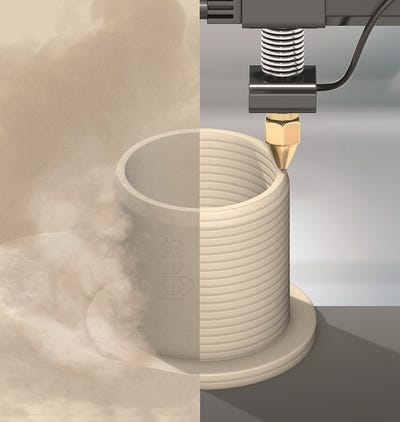Igus VP, Rick Abbate, offers his take on the state of 3D printing and its promises for the future.
October 11, 2021

Producing parts for moving applications can be tricky. Flexibility and lubrication can be major issues. Igus has solved this challenge by using 3D-printed parts. The materials used in the printing are self-lubricating and flexible. Another advantage of the additive manufacturing approach is a quick turnaround even when producing custom components in small batches, even a batch of one.
3D printing also offers the benefit of quick turnaround times and the high cost of tooling. igus uses selective laser sintering (SLS) materials that are optimized for wear resistance in worm gear profiles. The result is wear-resistance that is higher than traditional injection molding manufacturing. The company also utilizes generative design to create parts that are lighter and stronger than conventionally designed components.
We caught up with Rick Abbate, Vice President of igus, to get his take on why the company has invested in additive manufacturing.

Design News: For your customers, what is the advantage of 3D printing? Spare parts? Lighter parts? Parts needed quickly?
Rick Abbate: 3D printing provides engineers and designers the ability to produce components without having to invest in expensive tooling with long delivery times. igus customers benefit from additive manufacturing materials with high-wear resistance. Unlike standard printed plastic parts, all igus 3D-printed parts are low-friction, maintenance-free, and self-lubricating. This allows engineers to quickly develop highly efficient parts that can be used in moving applications, such as gears, bushings, leadscrew nuts, and more.
We can produce 3D-printed components for prototypes and small batches with no minimum order quantity required, and we can produce almost every part in as little as 24 hours. However, igus 3D-printing services go beyond just prototyping, extending even further into small-scale production and high-cycle applications up to 10,000 pieces.
Here's a live-action demonstration of igus 3D printing:
DN: What types of materials are serving these purposes?
Rick Abbate: Igus uses its injection molding materials knowledge to create 3D materials that offer specific advantages to the customer or application. This means, selective laser sintering (SLS) materials that optimize wear resistance in worm gear profiles meet U.S. FDA approvals for food contact applications and offer electrostatic discharge (ESD) protection.
Also, igus 3D materials include a range of special fused deposition modeling (FDM) filaments that offer ease of processing, high-temperature, and chemical resistance as well as compliance in burn testing and food contact areas. Igus FDM filaments are 50 times more wear-resistant than standard thermoplastic printing materials.
DN: What is important in a 3D printer? Reliability? Speed? The ability to produce a wide range of objects?
Rick Abbate: Igus primarily utilizes SLS printing for our print service. SLS offers an excellent balance of speed, part strength, and reliability. With motion parts we are typically producing, tolerance is an important topic, and we can achieve +/- 0.1mm. This production method also allows customers very few limitations with regards to part design and complexity and does not affect the costs in any way.
DN: Is the use of generative design growing in 3D printing?
Rick Abbate: Generative design is certainly an upcoming topic, especially in metal printed structural parts, as it offers huge cost savings. However, it is not such a big topic for igus, since we don’t focus on structural parts, but we do make use of the concept when designing multi-material prints that have a combination of bearing areas and structural areas. With this process, we are often reducing amounts of material leaving only what is required.

DN: What will determine the future of 3D printing – or additive manufacturing – production? Emerging materials? New printers? Generative design tools?
The future certainly seems to be focused on the availability of different materials, printer types, and capabilities. While many have access to lower-cost FDM machines to create quick prototypes in-house, fewer have the capital available to invest in a process such as SLS. A smaller footprint and lower-cost machines will increase the need for material availability.
DN: 3D printing is in a very different place now than it was 10 years ago. Where do you think 3D printing will be 10 years from now?
Rick Abbate: The traditional thought process focused on machining metals has shifted with the advantages of additive manufacturing. The newest developments at igus have taken 3D printing one step further and will revolutionize traditional manufacturing methods with intelligent components. At igus, smart sensors can be directly “printed into” the parts. These intelligent parts can warn against overload and report their maintenance requirements, reducing failure and downtime costs. As a result, 3D-printed smart components are not only low cost and can be quickly produced, but also provide Industry 4.0 integration.
Wear-resistant components for large-scale applications are also possible. Our large-format 3D-print services can be used to manufacture components up to 3m in a single printing process. The 3D-print materials have up to 50 times the abrasion resistance of ABS, PETG, or PLA. Large-format components made of igus materials can be easily used in larger applications such as special machine construction, automotive parts, or packaging technology. These large-scale 3D printed components fare well in direct comparison with machined parts due to their lightweight design, high wear resistance, and reduced costs to produce.
About the Author(s)
You May Also Like





